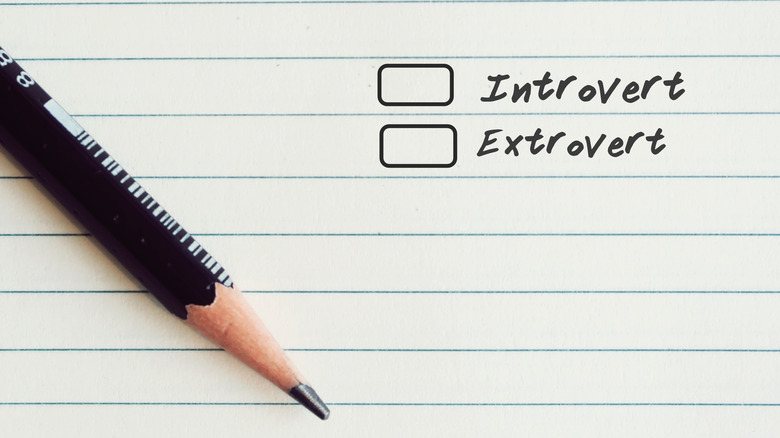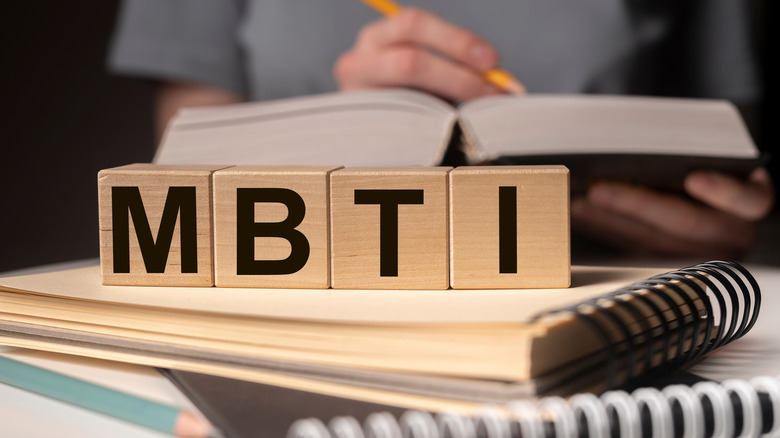Myers-Briggs: How The Famous Personality Test Really Works
INFJ, ENTP, ESFJ, INTJ, ISTP... The odds are good that you've seen versions of these four-letter combinations floating around the internet or at work and wondered what exactly they defined. These personality types are part of the 16 personality types created by the Myers-Briggs personality test, the most famous personality test in the world. But what exactly do they mean and how do you figure out what combination of letters properly describes you?
Personality tests like the MBTI have been around for more than a century. According to Dr. Jennifer V. Fayard, people love personality tests in all of their forms because they hope that they will reveal previously unknown information about themselves (via Psychology Today). They help people feel like they belong while simultaneously making it easier for them to understand the quirks and motivations of other people. "We all have beliefs about what we're like, what our personality is like [and] what our behavior is like," associate professor of psychology Chris Soto tells Discover. "And it just feels good to get feedback that lets you know that those beliefs are accurate."
More than 1 million people take the MBTI every year to help them unlock their personality type. Despite the debates surrounding the test's validity, the assessment remains a popular tool for personal growth and helpful self-discovery utilized by people the world over. Now, let's break down how this famous test works and what it can tell you about yourself.
What is the Myers-Briggs Type Indicator (MBTI)?
The Myers-Briggs test is a psychometric tool that, at its core, allows individuals to develop a clearer sense of who they are. The test claims to accomplish this by measuring how people perceive their world and make decisions in accordance with their psychological preferences. According to The Myers-Briggs Company, the MBTI is designed to identify people's core personality traits as well. By identifying these traits, people can learn how to communicate better, appreciate the strengths and differences others bring to the table, and ultimately become more self-aware.
The MBTI is widely considered to be the world's most widely used personality assessment. The test is used by a variety of organizations including life and job coaches, educators, and career counselors. Most people are familiar with the MBTI in a corporate capacity, as it's frequently used by companies to analyze job applicants or help determine the strengths and weaknesses of current employees. Marketplace explains that 89 of the Fortune 100 companies currently use the MBTI as part of their hiring process, for team-building workshops, and for executive talent management. It's also used by government agencies, universities, and hotel chains to aid in staff development, leadership training, and self-awareness.
How was the MBTI developed?
The famous self-reporting assessment tool began in the early 1900s with a mother-daughter duo from Michigan. Katherine Briggs and her daughter, Isabel Briggs Myers, were fascinated with the psychological theories and types created by Swiss psychiatrist Carl Jung.
According to NPR, Katherine Briggs was a brilliant, highly educated woman who graduated first in her college class. She worked as a homemaker but maintained a strong desire to conduct important research that would help other people figure out who they were, something she believed would help them live their best lives. As a young wife and mother, Briggs developed a questionnaire designed to categorize people's personalities. After reading Carl Jung's book "Psychological Types" in the early 1920s, Briggs struck up a correspondence with the famous psychoanalyst to pick his brain about the abstract categories he used to describe people's personalities.
Around World War II, her daughter Isabel began to expand upon this language and her mother's existing questionnaire (via Marketplace). Her goal was to design a test that helped people find jobs suited to their unique strengths. The language in the test was designed to be non-judgmental and provide test takers with the self-knowledge answers they needed to thrive and understand others better. The pair worked together to broaden Jung's initial work and make it more accessible for the average person to understand. Briggs and Myers worked for 20 years to create the test, publishing its first iteration in the early 1960s.
How does the MBTI work?
The MBTI consists of a series of simple, easy-to-understand online questions about your personal preferences, likes, and dislikes. According to the U.S. Chamber of Commerce, the questions are designed to categorize people into one of 16 different personality types. These personality types are derived from four opposing personality functions, or dichotomies, which were heavily inspired by Carl Jung's writings (via Truity). Each personality type has its own four-letter code, which was believed by Briggs and Myers to be a broad amalgamation of different personality preferences coming together to describe a single person.
The MBTI's four-letter codes are an abbreviation of the four type preferences, three of which Jung invented and one which Briggs created. The four dichotomies include Extroversion (E) and Introversion (I), Sensing (S) and Intuition (N), Thinking (T) and Feeling (F), and Judgement (J) and Perception (P). According to MentalHelp.net, each of these words has a different meaning within the context of the MBTI because the test measures aptitude rather than definitions. For example, a person who is categorized as preferring thinking over feeling is not necessarily more thoughtful than they are emotional. The difference lies in the preference of the individual. The degree to which an individual is or isn't a specific dichotomy doesn't matter either. According to Isabel Myers, it was more important to measure the general direction of a person's personality type than it was to pin down exactly how much of an introvert or extrovert you might be.
Extroversion (E) & Introversion (I)
The first letter of each personality type begins with E for extroversion or I for introversion. This element of the Myers-Briggs personality typing focuses on how a person gives and receives energy.
Traditionally, how extroverted or introverted a person is has a lot to do with how social they are or how much energy it takes for them to be around other people. Extroverted people are generally described as outgoing, talkative, and optimistic with a dislike of being alone for too long. On the other side of the spectrum are introverts, people who are energized by alone time and live quieter, more reflective lives. In the context of the MBTI, extroversion and introversion also exist on a scale. However, instead of focusing solely on the social aspects of a person's personality preference, the MBTI extroversion/introversion categories include how a person responds to their environment at any given moment.
People who are categorized as extroverted are thought to be comfortable verbally expressing themselves, love engaging with others, and are go-getters that accomplish their goals. Their strength comes from their desire to act as well as their ability to push limits and bring a lively, contagious energy to any gathering. Introverts prefer thinking things through before they act, choosing thoughtful engagement with others, and spending their time seeking knowledge and understanding. When an introvert needs to recharge their energy, they must do so alone away from noise and activity.
Sensing (S) & Intuition (N)
Sensing and Intuition are all about how a person learns and absorbs information. If you are a person who relies on your five senses to create meaning out of facts, you likely belong to the Sensing category. Sensors are generally very active, practical people who don't have time for fanciful notions or abstract thoughts. They are realistic people grounded in the here and now. Sensors are also incredibly factual, detail-oriented people that strongly believe there is a right way and wrong way to go about solving a problem. They learn best when they can see how to apply the knowledge to real life and generally prefer physical experiences over books or recordings.
On the other hand, if you typically prefer to think about the possibilities of something and spend a lot of your time daydreaming about the future, you may belong to the Intuition category. The Myers & Briggs Foundation notes that intuitives are people that are interested in experiencing new and different things but trust impressions and metaphors more than what they actually experience. They are heavily inspired by creative, high-level projects and don't care for digging into the details of anything. An intuitive appreciates imagination and innovation over pragmatism and spends much of their time trying to figure out how to change the world for the better.
Thinking (T) & Feeling (F)
The third dichotomy measured by the MBTI is Thinking/Feeling. People with the Thinking trait are critical thinkers who use logic, facts, and problem-solving to thrive. They are generally analytical, objective, and highly rational individuals. Thinkers are always weighing the odds of something and calculating the strategic nuances of a problem, preferring a slightly more detached view. Ultimately, thinkers often excel in scientific or mathematical fields.
Feelers approach decision-making in a much different way. People with the Feeling personality type make their decisions with their emotions rather than what they perceive. They value the emotional well-being of both themselves and others. In addition, feelers are highly empathetic creatures that possess a great capacity for caring, compassion, helpfulness, and nurturing. Whenever a feeler must make a decision about something, they often think about the situation from the inside, choosing to take other people's needs and wants into consideration in order to create a sense of balance.
Judging (J) & Perceiving (P)
The final dichotomy scale is Judging/Perceiving. This cognitive function measures how a person chooses to organize and interact with the outside world. Contrary to popular belief, it's not associated with how you are perceived by others or your inner self. Instead, it measures how you approach the outside world from an outward perspective.
The Judging personality is one that outwardly prefers their lives to have structure. Judgers are the type of people who make plans ahead of time, never waver in their decision-making, and are highly task-oriented. They crave closure to problems, feel frustrated by impulsiveness or ambiguity, and generally take their responsibilities extremely seriously. Judgers are also likely to follow through with their commitments. People with a Perceiving personality approach life from a more flexible, adaptable point of view. Perceivers are open and responsive to change, flirt dangerously with deadlines, and believe in seeking work-life balance. They are constantly seeking out new ideas, projects, and opportunities and firmly believe that the best way to get the most out of life is to keep their options open.
The eight introverted personality types
Both Katherine Briggs and Isabel Myers believed that every person was a combination of all the opposing personality functions. The letter associated with an individual's particular personality type was considered to be the dominant or preferred way of thinking, feeling, or decision-making, leading to the creation of the 16 personality groups. Each group contains eight introverted types and eight extroverted types, with a unique blend of references contained within each.
The eight introverted personality types are ISTJ, ISFJ, INFJ, INTJ, ISTP, ISFP, INFP, and INTP. People who fall into ISTJ are quiet, serious, practical, and responsible. Meanwhile, ISFJ people are known as Defenders. They're friendly, protective, and dedicated people who strive to create harmony. INFJ folks seek meaning and connection with others while remaining conscientious and committed to their values. Then, INTJ people are known as architects because they are skeptical but strategic thinkers with a strong penchant for competence and independence.
ISTP individuals are generally reserved, flexible, observant, and tolerant people categorized as Virtuosos (via Mindfulness Muse). ISFP people have artistic souls and flexible natures that love to experience new things. Moreover, INFP types are known as mediators. They are highly altruistic individuals with kind, idealistic, and poetic hearts. Finally, INTP folks prefer critical, analytical, and theoretical thought and are great at solving deep problems.
The eight extroverted personality types
The eight extroverted personality types are ESTP, ESTJ, ESFP, ESFJ, ENFP, ENFJ, ENTP, and ENTJ. ESTP personalities are called Persuaders because they are perceptive, outgoing, dramatic people that live in the present. ESTJ types, also known as directors, have a tendency to be assertive and lead others. Entertainers, or ESFPs, are exciting, energetic, and enthusiastic people that love to be the center of attention. People with the ESFJ personality type are known as caregivers because they are caring, popular, and social people that see the best in others.
ENFP, or champions, are free-spirited and charismatic people that love projects where they can put their creativity to work. ENFJ types are true protagonists. These positive individuals have strong ideas and values and never back down from an opportunity or a chance to lead others. ENTP, also known as debaters, thrive on intellectual challenges. They are smart, curious, and inventive people that are good at reading others. Finally, the ENTJ types, referred to as commanders, are bold and imaginative people that love to organize projects.
Benefits and criticisms of the MBTI
Despite its enduring popularity amongst the public, and its numerous revisions and adaptations over the years, the MBTI is a bit controversial in the scientific and psychological communities. There are a number of criticisms surrounding the MBTI, mainly that the self-reporting tool is a form of pseudoscience.
According to Simply Psychology, the dichotomies Carly Jung created aren't based on any methodologically sound study. The type of descriptive language used in the questionnaire is thought by many researchers to be vague and too broad, meaning it can apply to anyone exhibiting any behavior. The questionnaire itself has come under fire for its likelihood of bias. Many people who take the test may be motivated to fake their answers in order to achieve the personality type that they want to have. Furthermore, test takers can retake the test as often as they like in order to achieve a favorable result.
While it has its faults, there are also a number of benefits to the MBTI. Knowing your MBTI personality type can help individuals understand their preferred learning and decision-making styles, which can help them communicate better. It also provides insight into much-needed self-awareness and self-reflection.
The MBTI and the workplace
Employers and business owners are constantly searching for the best people to help their companies succeed, now more than ever. The MBTI is an excellent tool for assembling successful teams, helping project managers facilitate communication, developing leaders, and motivating employees to do their best work. The MBTI's applications in the workplace also help eliminate conflict and allow teams to work together and understand one another better. The MBTI's categories do this by teaching leaders and coworkers to play to their strengths while minimizing their weaknesses.
Despite its benefits and capacity for understanding employees and employers better, the MBTI is just a tool. According to Lattice Magazine, a publication for HR professionals, the MBTI and personality tests like it are only a small part of the overall management process. Knowing whether someone is introverted or more analytical than creative will not determine how successful someone may be in a particular workplace. HR manager Charlotte Kackley tells Lattice, "It's important not to attribute too much value to the assessment and to remember to use it simply as one tool of many in your toolbox."
Can the MBTI be used to predict romantic compatibility?
People are constantly wondering how romantically compatible they and their partner are, and will seek out everything from astrological compatibility tests to books like The Five Love Languages to find answers. Although its intended purpose was to help individuals understand themselves better, can the MBTI and its analysis of your personality type also predict romantic compatibility with your partner?
Some research suggests yes. In their book "Just Your Type: Create the Relationship You've Always Wanted Using the Secrets of Personality Type," Paul D. Tieger and Barbara Barron found that certain MBTI personality types are more compatible than others based on how they spend energy, how they communicate, and how they process feelings and emotions (via Goodreads). One 1992 study of the MBTI and its correlation with romantic attraction agreed, concluding that people choose their ideal mate based on how similar they are, particularly in the Sensing/Intuition and Extroversion/Introversion dichotomies (via APA PsychNet). The study also concluded that a personal-type bias existed already amongst couples, meaning that people valued not only people who were already similar to them personality-wise, but who possessed personality traits that are deemed socially acceptable. This study is dated, but its framework holds true.
Romantic compatibility depends on a number of unscientific factors, but tests like the MBTI can be used to help individuals understand the tendencies, similar behavior patterns, and preferences they have that align with their partner's. The MBTI was not intended to be a tool for evaluating romantic compatibility, but talking about your personality type with your partner may be a fun date night discussion regardless.
How reliable is the MBTI?
Despite its enduring commercialized popularity, the MBTI and its generalized people sorting have been scientifically debunked numerous times. The test's lack of validity is largely due to the fact that Katherine Briggs and her daughter, Isabel Briggs Myers, while both incredibly smart women, did not have a formal background in psychology. Their processes during the design of the questionnaire were unscientific as were the published results. Although the MBTI boasts a 90% accuracy rate for its participants, many scientists doubt that it actually measures what it claims to measure (via Job Talk). People are often skeptical of the results they receive post-test, with up to 50% of people who take it reporting that they received a different personality type when they take the test a few weeks later.
However, some people argue that the MBTI is as valid as any other personality type test. It is positive and nonjudgmental that allows individual people to align with the ideal version of themselves. Although any test claiming to unlock a unique person's personality should be met with some healthy skepticism, some argue that simply recognizing the good and bad parts of yourself in a classification of letters is a form of validity.













